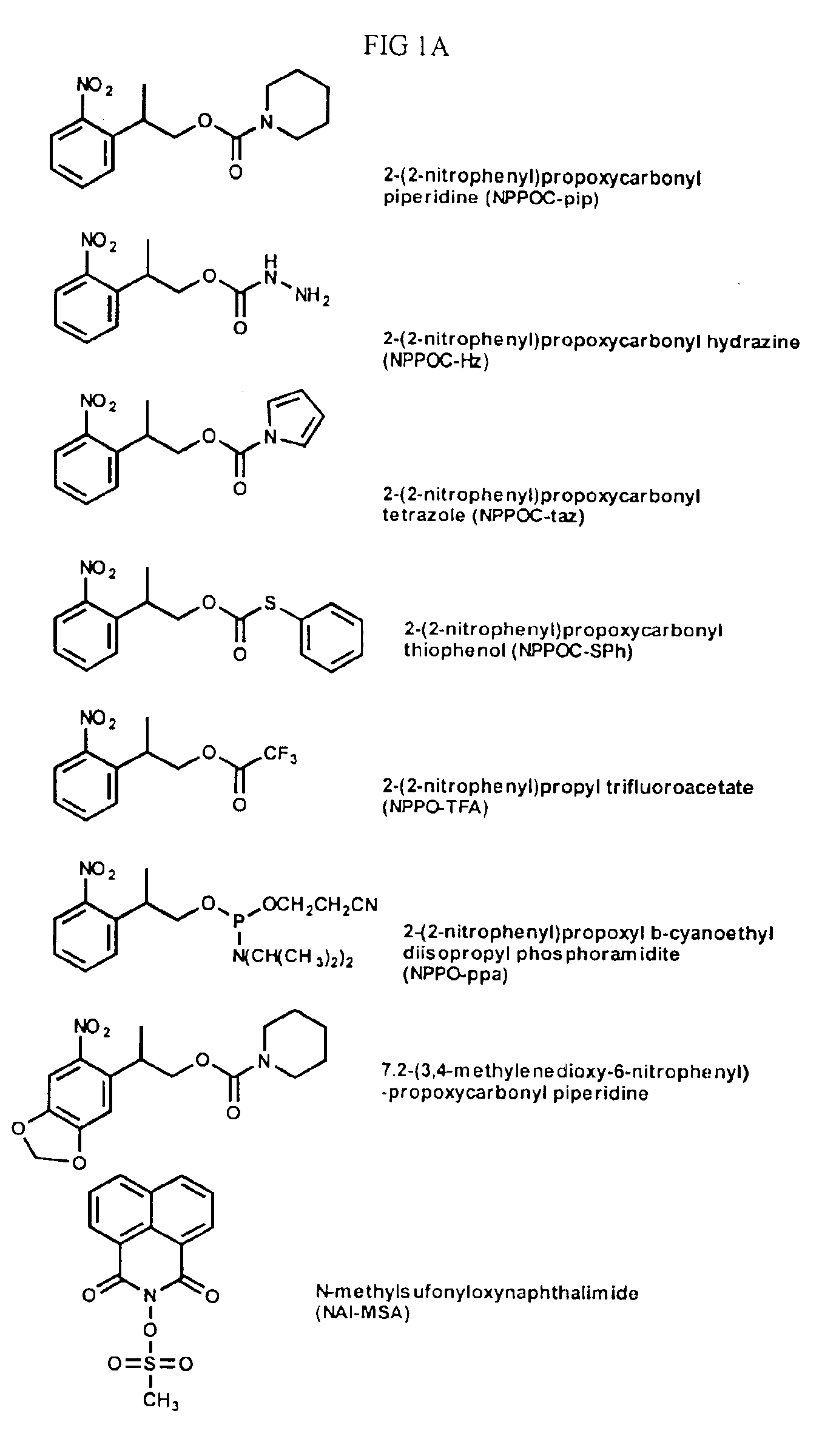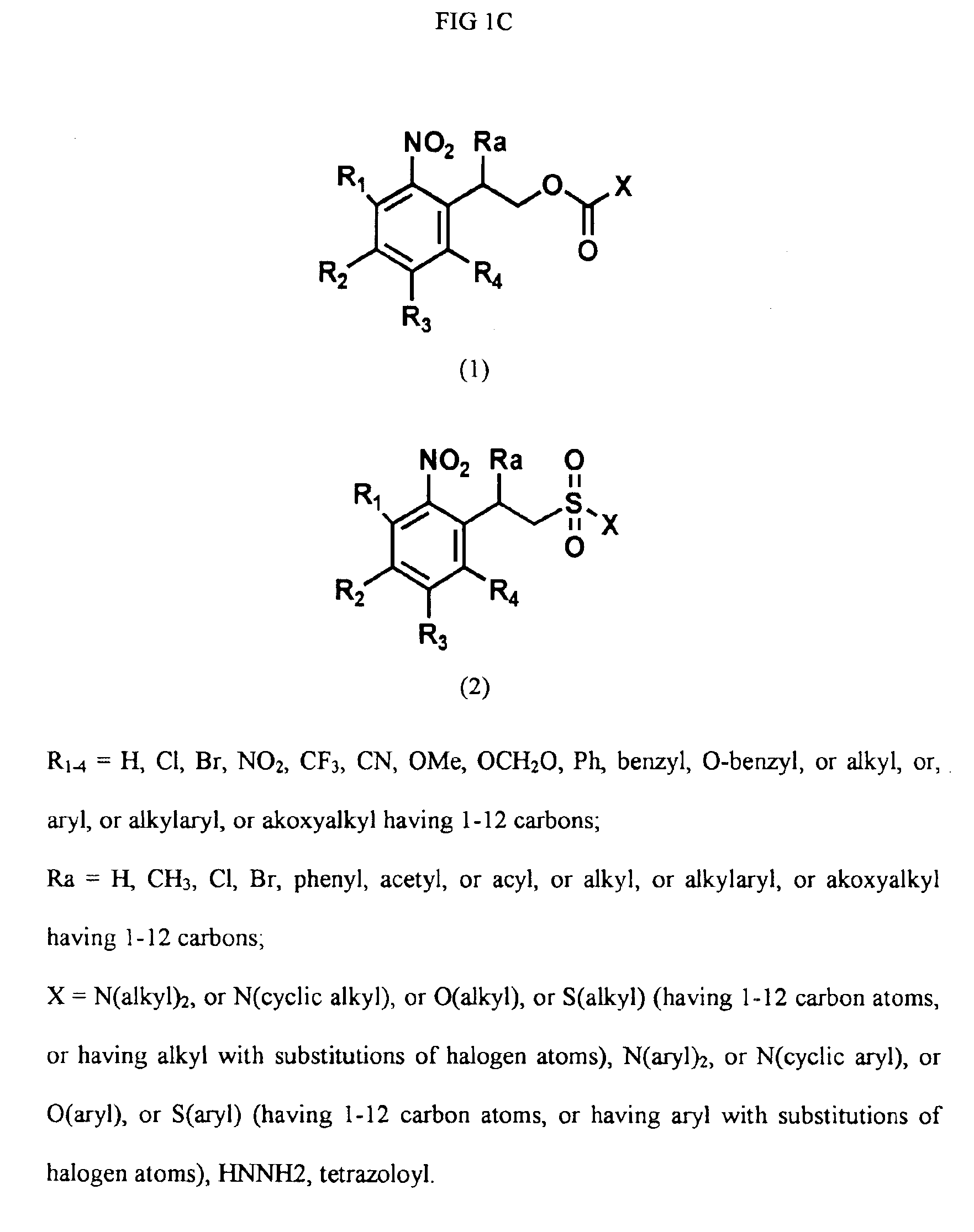Photogenerated reagents
a photogenerated and reagent technology, applied in the field of chemical and biochemical reactions, can solve the problems of heavy weight, electron withdrawal of the trifluoromethyl group,
- Summary
- Abstract
- Description
- Claims
- Application Information
AI Technical Summary
Benefits of technology
Problems solved by technology
Method used
Image
Examples
example i
Synthesis of 2-(2-nitrophenyl)propoxycarbonyl piperidine (NPPOC-pip)
[0066]2-(2-nitrophenyl)propoxyl chloroformate (FIG. 4A, eq. 1). 1-Ethyl-2-nitrobenzene (13.5 mL, 100 mmol) was dissolved in dimethylsulfoxide (100 mL). Paraformaldehyde (4.50 g, 150 mmol) and KOtBu (2.81 g, 25 mmol) in t-butyl alcohol (30 mL) were added and the mixture was stirred at room temperature for 3 h. The solution was washed with a molar solution of HCl (25 mL), followed by brine (3×100 mL). All the aqueous layers were combined and extracted with ethyl acetate (3×100 mL). The organic portion was dried (MgSO4), filtered and the solvent was removed in vacuo. The crude product was purified on a silica gel column. Elution of the column with 20-30% ethyl acetate in hexanes gave 16.12 g (89 mmol, 89% yield) of 2-(2-nitrophenyl)propanol. 1H-NMR (600 MHz, DMSO-d6): δ 7.75 (d, J=8.10 Hz, 1H, Ar—H), 7.63 (t, J=7.62 Hz, 1H, Ar—H), 7.58 (d, J=7.80 Hz, 1H, Ar—H), 7.42 (t, J=7.50, 1H, Ar—H), 4.73 (t, J=5.30 Hz, 1H, OH), 3...
example ii
[0069]2-(2-nitrophenyl)propoxycarbonyl hydrazine (FIG. 4A, eq. 3, R=102) (NPPOC-Hz). A solution of 2-(2-nitrophenyl)propyl chloroformate (6.0 g, 24.6 mmol) in methylene chloride (20 mL) was added dropwise to a solution of hydrazine (3.0 mL, 98 mmol) in methylene chloride (50 mL) over a period of 30 min. The reaction mixture was stirred at room temperature for an additional 15 min. The solvent was evaporated to afford light brown oil. The residue was purified on a silica gel column. Elution of the column with 20% ethyl acetate in hexanes gave 3.35 g (14 mmol, 57% yield) of 2-(2-nitrophenyl)propoxycarbonyl hydrazine. 1H-NMR (600 MHz, DMSO-d6): δ 8.10 (s, 2H, CONH), 7.82 (d, J=7.5 Hz, 1 H, Ar—H), 7.67 (m, 2 H, Ar—H), 7.47 (m, 1 H, Ar—H), 4.15 (d, J=7.2 Hz, 2 H, CH2), 3.9 (s, 2 H, NH2), 3.39 (m, 1 H, CH), 1.25 (d, J=6.9 Hz, 3 H, CH3). 13C-NMR (150 MHz, DMSOd6): δ 157.99 (OCOR), 150.00 (C ipso to NO2), 136.72 (C ipso to CH(CH3)CH2OCOR), 132.86 (C para to NO2), 128.55 (C para to CH(CH3)CH...
example iii
[0070]Di-(2-(2-nitrophenyl)propoxycarbonyl) hydrazine. A solution of hydrazine (0.32 mL, 10.25 mmol) in DCM (20 mL) was added dropwise to a solution of 2-(2-nitrophenyl)propyl chloroformate (5.0 g, 20 mmol) in methylene chloride (25 mL) over a period of 30 min. The reaction mixture was stirred at room temperature for an additional 15 min. The solvent was evaporated and the residue was purified on a silica gel column. Elution of the column with 20% ethyl acetate in hexanes gave 1.46 g (3.26 mmol, 32% yield) of di-(2-(2-nitrophenyl)propoxycarbonyl) hydrazine. 1H-NMR (300 MHz, DMSO-d6): δ 9.06-8.73 (d, 1 H, CONH), 7.84 (d, J=7.8 Hz, 1 H, Ar—H), 7.63 (m, 2 H, Ar—H), 7.48 (m, 1 H, Ar—H), 4.20 (m, 2 H, CH2), 3.39 (m, 1 H, CH), 1.26 (d, J=6.9 Hz, 3 H, CH3). 13C-NMR (75 MHz, DMSO-d6): δ 156.19 (OCOR), 149.85 (C ipso to NO2), 136.53 (C ipso to CH(CH3)CH2OCOR), 132.91 (C para to NO2), 128.52 (C para to CH(CH3)CH2OCOR), 127.76 (C ortho to CH(CH3)CH2OCOR), 123.77 (C ortho to NO2), 67.86 (CH2OCO...
PUM
| Property | Measurement | Unit |
|---|---|---|
| temperature | aaaaa | aaaaa |
| excitation wavelength | aaaaa | aaaaa |
| wavelengths | aaaaa | aaaaa |
Abstract
Description
Claims
Application Information
 Login to View More
Login to View More - R&D
- Intellectual Property
- Life Sciences
- Materials
- Tech Scout
- Unparalleled Data Quality
- Higher Quality Content
- 60% Fewer Hallucinations
Browse by: Latest US Patents, China's latest patents, Technical Efficacy Thesaurus, Application Domain, Technology Topic, Popular Technical Reports.
© 2025 PatSnap. All rights reserved.Legal|Privacy policy|Modern Slavery Act Transparency Statement|Sitemap|About US| Contact US: help@patsnap.com



